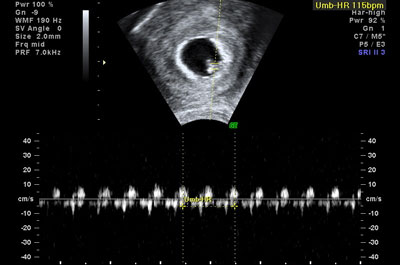When you heard your baby’s heartbeat through ultrasound monitoring, you were probably delighted, entranced and mystified by that tiny, internal life. You might have also wondered if your baby’s fetal heart rate was normal during your pregnancy. We promise, this isn’t the first time you’ll wonder if your baby’s development is “normal” in comparison to others. While most pregnant women won’t get to hear their baby s heartbeat in the first week, or even the first trimester, this shouldn’t make you worried – you can hear it as early as the sixth week! The fetal heart rate varies during the stages of pregnancy, and with help from regular health care, monitoring and frequent ultrasound appointments, it won’t be long before the time comes to hear that first beat. Click on the bar below to hear a fetus’ heartbeat!
At about 5 weeks of gestation during pregnancy, your baby’s heart begins to beat, and you will get to hear your baby s fetal heart rate with an external method such as a Doppler ultrasound. Doppler device uses sound waves using fluid in the amniotic sac to check the flow of blood in the baby, and is also used when monitoring the baby’s heart rate.
During this trimester, the baby s heartbeat is slightly higher than that of the mother, about 100 beats per minute (bpm). From this point on during pregnancy, the baby s heart rate frequency will increase by around 3 beats per minute per day during that first month. This system is so accurate that your doctor could use the mother s heart rate to help determine your baby’s gestational age.

By the beginning of the 9th week of pregnancy, the normal fetal heart rate is an average of 175 bpm (beats per minute). At this point, a rapid deceleration of the fetal heart rate begins, reaching around 110-160 beats per minute in mid-gestation. There is also a slow deceleration in fetal heart rate in the last ten weeks of pregnancy. It is important to note that variations in a baby s heart rate is normal, just as with an adult’s heart rate. Whether it will get higher or lower, rest assured your baby is fine! You will find that sleep, movement, and other related prenatal activities can contribute to these normal, healthy variations in your baby s heart rate, and your doctor has a system to test and monitor each beat.
Fetal Heart Rate Reference Table
| Gestational Age / Fetus Size Normal | Fetal Heart Rate |
| 2 mm embryo | 75 beats per minute (bpm) |
| 5 mm embryo | 100 beats per minute (bpm) |
| 10 mm embryo | 110 bpm to 120 bpm |
| 15 mm embryo | 130 beats per minute (bpm) |
| 5 Weeks | starts at 80 and ends at 103 bpm |
| 6 Weeks | starts at 103 and ends at 126 bpm |
| 7 Weeks | starts at 126 and ends at 149 bpm |
| 8 Weeks | starts at 149 and ends at 170 bpm |
| 9 Weeks | 155-195 bpm (average 175 bpm) |
| 12 Weeks | 120-180 bpm (average 150 bpm) |
| After 12 Weeks | 110-160 bpm (average 140 bpm) |
What is a False-Positive Reading?
False-positive fetal heart rate monitoring readings – which may indicate there is a problem when the baby is actually fine – are common.Your doctor has a range to classify your baby’s prenatal development and fetal heart rate readings during pregnancy. The range is reviewed according to three categories:
- Category One: Everything is normal and no action or test is needed.
- Category Two: Readings are unclear and may be further reviewed, or require more internal information such as an additional test, evaluation and surveillance.
- Category Three: Readings around the heart rate are abnormal (higher or lower) and may require prompt evaluation and action.
Medical professionals can see fairly early on when a baby s heart looks normal and healthy (category 1) and know when something is wrong during gestation and we need to take immediate action (category 3). In the middle, it may get complicated, and this range is where false-positives often show up based on what your doctor can and can’t see through external ultrasound monitoring. A lot of factors go into assessing if a baby is healthy during birth – for example, the mother’s pregnancy health from the first trimester affects the baby, and must be reviewed as early as possible. This is where the use of one device can’t replace the care of a good doctor. The results are usually related to the context of what’s going on around gestation during any given week, and we know an internal fetal heart rate device can’t give us this information.
What can fetal heart rate monitoring tell us about your baby’s heartbeat during labor?
If you’re between 38-42 weeks in your pregnancy and you’ve gone into labor, your medical team will immediately set up fetal heart rate monitoring to first asses your baby’s heartbeat and health during birth. The main purpose of fetal heart rate monitoring is to provide information by observing your baby s heartbeat and alerting your doctor if your baby may not be getting enough oxygen or blood flow. We want to see your healthy baby come through pregnancy, labor and delivery as smoothly as possible. We don’t want the stress of labor to threaten a baby s heart, health or development, which is why a monitoring system as early as possible is so essential.
A baby s heart rate during labor should be between 110 and 170 bpm (beats per minute) depending on which week you’ve gone into labor, but it may fluctuate above or below this rate for a variety of reasons. Short bursts of acceleration of the baby’s heart rate are usually common and indicate that the baby is getting an adequate oxygen supply. We know that brief decelerations in the baby s heart rate are also normal and do not indicate poor fetal health. Accurate results are based on the use of a monitoring system reviewed by your health care team, regardless of how many weeks of gestation your baby is.
If these accelerations or decelerations are not occurring at the stages they should be, or if they are prolonged, it may mean a number of things, such as the umbilical cord is compressed and blood flow to the baby has been slowed. Usually, a simple method used, such as changing your labor position, may improve the situation and increase blood flow. If, when monitoring the birth, the fetal heart rate results indicate that your baby may be in danger (such as an irregular beat), your doctor may make a decision to rupture the amniotic sac to accelerate delivery, or recommend an operative vaginal delivery or a cesarean section.
Is it possible to determine my baby’s sex by the fetal heart rate?
According to an old wives’ tale, if your baby’s fetal heart rate is greater than 140 bpm, the baby is female. If the fetal heart rate is below 140 bpm, it is a boy. Of course, superstition is not used to test fetal monitoring – if it were this easy to tell the baby’s gender, obstetricians would be out of a job! Your baby’s fetal heart rate has nothing to do with his gender. A study from the 1980’s disproved this heart rate “myth” after examining more than 10,000 babies; a secondary study conducted in 2006 would help reconfirm what scientists already knew: there is no relationship between fetal heart rate and the sex of the baby. An ultrasound during pregnancy is usually the easiest and most accurate way to make sure.
One accurate predictor is the use of ultrasonography, which identifies the baby’s sex by examining fetal anatomy depending on the trimester. Find out from your doctor when you’ll be able to see your baby’s sex on ultrasound.



